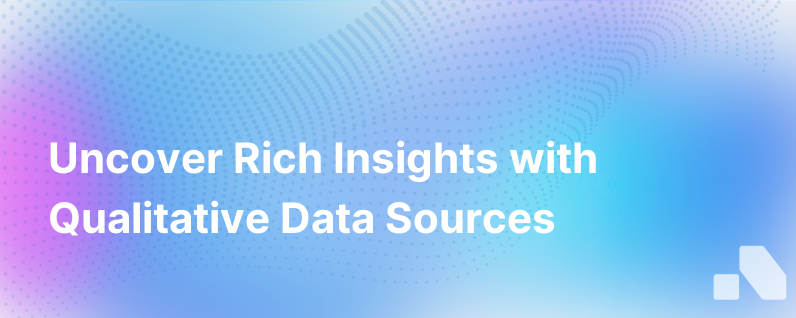Qualitative Data Sources
Published on December 29, 2023 by Sawyer Middeleer
To propel our businesses forward, we constantly look for insights mining through vast amounts of data. While quantitative data often takes center stage due to its measurability, qualitative data is utterly invaluable too. Unlike its quantitative counterpart, which focuses on hard numbers, qualitative data delves into human behavior, feelings, and perspectives, providing businesses with an in-depth understanding of their customers.
This deep understanding will often be the difference between product success and failure, draft the lines between a good or bad user experience, or make or break customer retention. Hence it's crucial to explore the most effective qualitative data sources and ways of using them to facilitate effective decision-making. Let's dive in.
Understanding Qualitative Data
Before we delve into the sources, it's crucial to distinguish what qualitative data is. It gives you the 'why' behind the 'what' that's provided by quantitative data. It offers insights into user behavior and perception, motivations, choice factors, experiences, and preferences. This data type primarily exists in a non-numerical, textual format and often requires interpretation or judgment for information extraction.
1. User Interviews
User interviews are a pivotal source of qualitative data, accommodating the in-depth exploration of users' perspectives on your product or service. By conducting one-on-one interviews, businesses can ask users about their needs, get feedback on user interface design or understand the decision process that led them to buy or not buy a product.
Remember, effective user interviews require well-crafted questions that eschew leading the interviewee. The aim isn't to confirm expectations, but to gain true and unbiased user insights.
2. Focus Groups
Focus groups, typically consisting of 6-10 users, provide an interactive platform for qualitative data collection. The strength of this method lies in its capacity for dynamic, multi-layered conversation that reveal user perspectives. By listening to the conversations and debates that arise during these discussions, you may gather unexpected insights.
3. In-depth Case Studies
In-depth case studies enable a profound analysis of particular user interactions with a product or a service. Businesses can study the user's journey from initial contact to either adoption or rejection of a product or service. These generally combine multiple qualitative data sources together for a multifaceted view.
4. Observation and Ethnography
Direct observation, usually in the form of usage logging, explores user behavior in real-time. This method reveals the product interactions that users might not remember or consciously be aware of, meaning they might not mention them during interviews or focus groups.
5. Open-ended Surveys and Feedback Forms
While often utilized for quantitative data collection, surveys may also collect qualitative data through open-ended questions. User comments and suggestions can unveil preferences or pain points that were previously unnoticed.
Similarly, customer feedback forms often present qualitative insights, with customers detailing their issues, snags, or positive experiences unprompted.
6. Social Media and Online Reviews
You can gain a wealth of qualitative data by monitoring social media platforms and online reviews where customers discuss their experiences with your brand enthusiastically and honestly. There are advanced social listening tools that can help your business spotlight relevant conversations.
How to Use Qualitative Data?
Deriving value from qualitative data requires rigorous analysis often involving coding the data (assigning it thematic categories) and looking for patterns or connections. Utilizing qualitative data analysis tools can help manage and assist this process.
The insights extracted from the qualitative data can help businesses:
- Improve products or services based on direct user feedback
- Enhance user interface based on usage habits
- Inform marketing strategies
- Understand granular customer behavior
- Tailor unique customer experiences
- Formulate better customer retention strategies
In Conclusion
While time-consuming to analyze, qualitative data provides a deeper understanding of your users – a factor crucial to the increasingly customer-focused world of business. It provides the depth and nuances that quantitative data often misses, giving businesses the tools to provide more personalized, successful products or services.
At Aomni, we understand the power of a robust data analysis strategy that includes qualitative data. Our AI-driven platform processes and analyzes both qualitative and quantitative data from multiple sources, delivering actionable, strategic insights in real-time, thus taking the guesswork out of decision making. By giving your business an in-depth understanding of your customers, Aomni helps you sell more strategically and stay ahead in the ever-competitive market landscape.